Michelle I. Mason's Blog: Michelle I. Mason
December 31, 2024
What I Read in 2024
Happy New Year’s Eve!
It’s time for my annual reading recap! I’m never quite sure until I look over my reading for each year how it will stack up against previous years. It turns out 2024 looks pretty similar to 2023. As of this morning, I’m at 88 books, but I might eke out one more today. Last year I finished 90 books. Here are a few trends:
As with 2023, I continued rereading some of the books on my existing shelves. I ended up rereading two rather long series, so as a result, one-third of the books I read this year were rereads. I love returning to the comfort of a familiar book.Earlier in the year, I was still trying to fix that pesky mystery novel, so I continued to read a lot of mysteries/thrillers. Plus, I like them!My adult reading was up a bit more than last year, but the long historical romance series I reread contributed greatly to that number.Here are my overall age category numbers as compared to the last couple of years. Next year I might start tracking genre too.
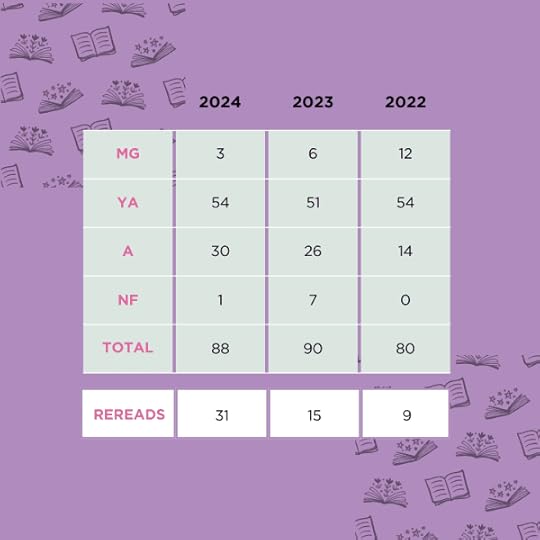
And here’s the list of books. It’s impossible for me to pick favorite reads anymore, but if there’s an asterisk, it means I added it to my permanent collection–or intend to. Honestly, I read so many great books this year, I might still pick up more, because as you can see, I love to reread (marked with an R). As you might have guessed, those books are already in my permanent collection.
Lying in the Deep by Diana UrbanThe It Girl by Ruth WareSnow in Love by Kasie West & others (R)Every Time You Go Away by Abigail Johnson*The Case of the Cryptic Crinoline by Nancy SpringerAfter Midnight by Teresa Medeiros*The Vampire Who Loved Me by Teresa Medeiros (R)How to Date a Superhero (And Not Die Trying) by Cristina FernandezGeek Girl by Holly Smale (R)All Wrapped Up by Holly Smale (R)Model Misfit by Holly Smale (R)Geek Drama by Holly Smale (R)Picture Perfect by Holly Smale (R)All That Glitters by Holly Smale (R)Sunny Side Up by Holly Smale (R)Head Over Heels by Holly Smale (R)Cruise Confidential by Brian David BrunsForever Geek by Holly Smale (R)Love, Me by Jessica SaundersOnce More with Feeling by Elissa SussmanBetting on You by Lynn PainterWith A Little Luck by Marissa MeyerDungeons and Drama by Kristy Boyce*The Getaway List by Emma LordThey Went Left by Monica HesseThe Wrong Mirror by Emma DarcyAll Around the Town by Mary Higgins Clark (R)The Case of the Disappearing Duchess by Nancy SpringerEnola Holmes and the Boy in Buttons by Nancy SpringerEnola Holmes and the Black Barouche by Nancy SpringerEnola Holmes and the Elegant Escape by Nancy SpringerEnola Holmes and the Mark of the Mongoose by Nancy SpringerHappy Place by Emily HenryAn Improbable Season by Rosalyn Eves*One of Us Is Next by Karen McManusThe Rose Code by Kate QuinnAn Unlikely Proposition by Rosalyn EvesThe Princess in the Opal Mask by Jenny Lundquist (R)The Opal Queen by Jenny Lundquist (R)The Name Drop by Susan LeeMorrigan’s Cross by Nora RobertsKill Her Twice by Stacey Lee*Destroy the Day by Brigid KemmererThe Ballad of Darcy & Russell by Morgan MatsonField Rules by Carla Luna*Twelfth Knight by Alexene Farol FollmuthLove, off the Record by Samantha Markum*12 to 22 by Jen Calonita*The Perfect Mistress by Victoria Alexander (R)His Mistress by Christmas by Victoria Alexander (R)Same Time, Next Christmas by Victoria Alexander (R)My Wicked Little Lies by Victoria Alexander (R)Lord Stillwell’s Excellent Engagements by Victoria Alexander (R)The Importance of Being Wicked by Victoria Alexander (R)What Happens at Christmas by Victoria Alexander (R)The Scandalous Adventures of the Sister of the Bride by Victoria Alexander (R)Hearts Overboard by Becky DeanThe Unwedding by Ally CondieHeir, Apparently by Kara McDowell*Meet Me in Ivy Falls by Amy True*The Shocking Secret of a Guest at the Wedding by Victoria Alexander (R)One of Our Kind by Nicola YoonThe Grandest Game by Jennifer Lynn Barnes*My Salty Mary by Cynthia Hand, Brodi Ashton and Jodi Meadows*Everyone in My Family Has Killed Someone by Benjamin StevensonLies and Weddings by Kevin KwanThe Daring Exploits of a Runaway Heiress by Victoria Alexander (R)The Taming of the Shrew by William Shakespeare (R)Authority by Jamie Krakover* (R)If I’m Being Honest by Emily Wibberley and Austin Siegemund-BrokaThe Break-Up Pact by Emma LordTwo Summers by Aimee Friedman (R)Everything Sad Is Untrue by Daniel NayeriIn Some Other Life by Jessica Brody (R)First Lie Wins by Ashley ElstonMagic Dark and Strange by Kelly PowellI Woke Up Dead at the Mall by Judy SheehanBye Forever, I Guess by Jodi Meadows*Also Known As by Robin BenwayNear Misses & Cowboy Kisses by Katrina EmmelSixteen Scandals by Sophie Jordan*Mr. Malcolm’s List by Suzanne AllainHow to Survive Your Murder by Danielle ValentineIn Want of a Suspect by Tirzah PriceGirl Overboard by Sandra BlockThin Air by Kellie M. Parker*Right Here, Right Now by Shannon DunlapSpectacular by Stephanie Garber*What did you read in 2024? Anything that was on my list? Do you have any recommendations for me in 2025 based on what I enjoyed this year? I’m always up for recommendations!
The post What I Read in 2024 appeared first on Michelle I Mason.
September 10, 2024
What’s That Other Character in the Scene Thinking?
Happy September!
Does it feel like fall yet where you are? Here in Missouri, we’re at the stage where it’s cool in the morning and evening, downright cold overnight, but still hot in the middle of the day. I’ve resorted to switching the HVAC from heat to air conditioning.
September marks the third anniversary of the release of Your Life Has Been Delayed (Sept. 7) and the second anniversary of My Second Impression of You (Sept. 20). To celebrate, I’m currently running a giveaway for a signed copy of YLHBD on Instagram. It closes on Thursday, Sept. 12, but please enter if you don’t already have a copy. In addition, my September newsletter, out today, includes bonus features for both books.
In August, my family took a trip up to Montreal, which is a fascinating city, with its French and British influences. We stayed in Old Montreal, near the Place d’Armes. There was a very interesting piece of art in the square that I think speaks to point of view. Make sure you read the caption, which I copied directly from the plaque.


I love how this art shows an inside glimpse of each of these people–who are definite stereotypes–and then also the dogs, who rise above. In general, I love playing with perspective. If you’ve read My Second Impression of You, you’ll already know that, as it’s all about Maggie getting an inside look at other perspectives. For that particular book, I gave readers a glimpse inside other characters’ heads along with Maggie, but it’s not a new concept for me as a writer. I do it quite often as I’m drafting and revising.
Let me back up a minute. Before I start drafting, I fill out detailed character sheets for not only my main character but the supporting characters in each of my books. These character sheets include basic info like their age, physical description, personality, habits, and mannerisms, but they go beyond the surface. Often I’ll include paragraphs of backstory to explain their motivations, highlighting their internal and external conflicts. Even with all of this planning, there are scenes where I need to actually get inside their heads to figure out why they’re behaving a certain way in that moment. It’s generally because it makes no sense to the main character and by extension the reader. But once I write it from that other character’s point of view, I can flesh out the scene from the POV character, who will likely interpret those reactions in a very different manner.
I’ll give you an example. I recently was working on a mystery, and I struggled with the motives of a number of characters. There were big questions like:
Why did they commit this crime?Why would they go along with this scheme?How could they be so clueless about this other character?Why did they make this obviously outrageous (to the reader) decision?But there were also smaller ones like:
Why did they react–or not react–during this key moment?What are they thinking when they say…?Are they putting on an act or do they have no idea what’s going on?What do they hope to gain by taking x action?How does this character react when cornered? Calm and calculated or panicked and reaching for anything to save their skin?Does the character rely more on logic or emotion?Sometimes instead of writing out a specific scene, I’ll do a full synopsis for the other character. That’s the case for my most recent project. Instead of needing to see how the love interest would react within their scenes together, I needed a fuller picture of what happened in between. I wrote out a synopsis of the story from his point of view, including scenes that didn’t involve my main character. Some of those scenes are referenced in the book, but some are just for my own information, to understand his actions/reactions.
I’m sure you’ve heard the statement that every character is the main character of their own story–even the villain/antagonist. The reader may not get the opportunity to see inside those character’s minds, but they should still see glimpses through the main character. The book will be that much richer for it.
What are some of your favorite secondary characters in books? What made them stand out to you?
The post What’s That Other Character in the Scene Thinking? appeared first on Michelle I Mason.
July 9, 2024
The Comfort of A Familiar Story
How is it July already? 2024 sure is flying by!
I’ve been on quite a reading binge lately. Currently I’m re-reading a series of ten adult historical romances that are all connected. It’s part of my effort to go through my existing catalogue of books and decide which I’ll keep to read again and which ones will move to the donation pile. These I still enjoy after a decade, so they’re keepers!
Because I’m reading these books all in a row by the same author, I’ve noticed a number of patterns in them, but rather than find them repetitive, I find it comforting.
And it’s not just when I read a long series from the same author. Patterns happen with certain genres. Like, I might pick up a romance novel and recognize a familiar trope, like: Ooh, fake dating! (One of my favorites.) They’re sure it will never turn into anything real, but of course by the end they’ll get together.
Or, in a fantasy or dystopian: Okay, this character’s the chosen one. They’re destined to save this world. They’ll put together a crew of people to help them, but when it comes down to the final battle, only they can defeat the huge evil.
I’m a fan of tropes because I know what to expect. If I pick up a romance novel, I expect a happy ending. If I pick up a chosen one type novel, I expect the good guys to win. I’d also prefer for the chosen one to live (don’t get me started on one particular dystopian trilogy).

There’s another type of familiar story I especially enjoy–retellings. I recently picked up Jen Calonita’s 12 to 22, which is the author’s middle grade version of the movie 13 Going on 30, and it made me smile all the way through. Granted, that’s one of my favorite movies, but what struck me was how I anticipated certain plot points without knowing exactly how they would play out in this version. Because the story is familiar to me, I knew what was coming and was already cringing on behalf of the character, but she had no idea. That feeling creates a unique kind of tension as you read. Instead of “I have no idea what’s going to happen next,” it’s “I know what’s coming and I can’t wait to see how it plays out.”
As an author and reader, it’s a great reminder that there are different ways to experience this tension. I enjoy reading a book where I’m trying to figure out all the twists and turns, but I also enjoy the books where I’m in on the secret but don’t yet know how the characters will handle what’s coming. That second instance–the one of familiarity–is why I will read any Jane Austen or Shakespeare retelling I can find. I love new twists on those stories. But I also love finding twists on more modern stories that are already familiar. Bring on all the rom-com retellings in book form!
My takeaway is this: anticipating what’s coming doesn’t remove the tension. It just changes it to a different kind of tension. And you never know–the author might throw in a completely unexpected twist. Depending on how attached you are to the original material, you might love the new version or completely hate it. The beauty of it is, you can always go back to the original.
For me, personally, I’m going to care most if you take away the happy ending. But in general if it’s a retelling rather than an adaptation, all bets are kind of off anyway.
What are some of your favorite retellings? Bonus points for any rom-com retellings, YA or adult! Here are some I’ve loved over the past five years. A few of these authors might not have been going for an outright retelling, but the stories still give retelling vibes.
The House Swap by Yvette Clark (MG The Holiday + The Parent Trap)When You Get the Chance by Emma Lord (YA Mamma Mia)So Many Beginnings by Bethany C. Morrow (YA Little Women)Love, Decoded (YA Emma) and A Taste for Love (YA Pride and Prejudice) by Jennifer YenSense and Second-Degree Murder (YA Sense and Sensibility) and Pride and Premeditation (YA Pride and Prejudice) by Tirzah PriceThis Might Get Awkward (YA While You Were Sleeping) and One Way or Another (YA Sliding Doors) by Kara McDowellWhere the Rhythm Takes You by Sarah Dass (YA Persuasion)Shipped by Meredith Tate (YA You’ve Got Mail)A Curse So Dark and Lonely by Brigid Kemmerer (YA Beauty and the Beast)Hood by Jenny Elder Moke (YA Robin Hood)Midsummer’s Mayhem by Rajani LaRocca (MG A Midsummer Night’s Dream)The Afterlife of Holly Chase by Cynthia Hand (YA A Christmas Carol)Twisted fairy tales by Jen Calonita and other authors (YA versions of Disney movies changing central plot points)My July newsletter is out today! I will definitely be doing subscriber-only giveaways in the next couple months, so make sure you sign up to be included.
The post The Comfort of A Familiar Story appeared first on Michelle I Mason.
June 11, 2024
Coping with Rejection
During World Read Aloud Day, a student asked me:
Have you been rejected before and how did you deal with the disappointment?First of all:
Unfortunately, rejection is part of life as a writer. It’s extremely rare for an author’s first published novel to also be the first book they’ve written, particularly in traditional publishing. The process involves:
That is a really shortened version that skips all kinds of angst that happens in between, including tons of–you guessed it–rejection. It can take years to get through each of these steps. In my case, step two took seven years. Before Your Life Has Been Delayed, I queried six different books and was rejected more than 600 times. Here’s how those stats broke down:
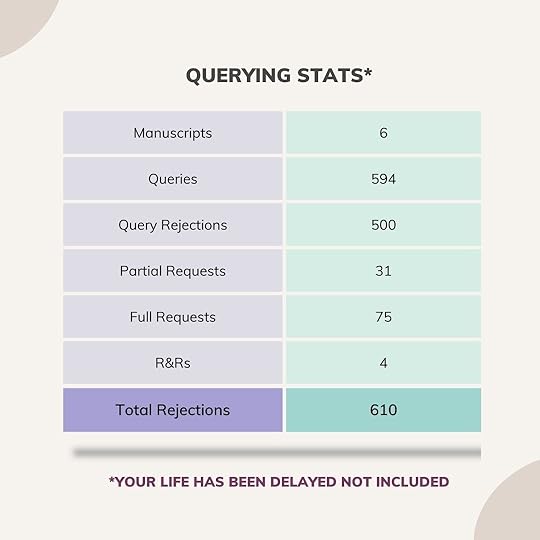 There are more rejections than queries because some of those partial requests turned into full requests before rejections, and four of those full requests turned into R&Rs before rejections. Anyway, the math does work, I promise!
There are more rejections than queries because some of those partial requests turned into full requests before rejections, and four of those full requests turned into R&Rs before rejections. Anyway, the math does work, I promise!
I didn’t track the stats for YLHBD because it was quite a whirlwhind. If you’d like to read more about my querying experience, I have a series about what I learned each year here on my blog. You can find the last entry here: What I’ve Learned in Seven Years of Querying. To read about signing with my agent a few months later: I Have An Agent. You can also find other posts about querying on my Resources page.
While I have quite a bit of distance now from the querying rejection, there are still many other kinds of rejection that occur as a published author:
Lack of salesLack of reviewsBookstores failing to stock the bookNegative reviews in which the author is tagged (please never do this!)Subsequent books that don’t come together or don’t sellSelf-promotion that seems to go nowhereNot being invited to a festival/eventI could definitely add more to this list, but I don’t like to dwell on the rejection–hey, that’s part of how I cope with it! So let’s move on to that.
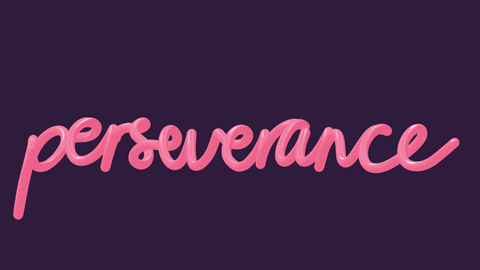 With both querying rejection and the kind that comes post-publication, the biggest thing is to PERSEVERE. I’m a pretty stubborn person in general. If I say I’m going to do something, I stick to it. I was determined to become a traditionally published author, so I kept working at it until I wrote the right book at the right time. Here are a few other ways I continue to survive rejection:
With both querying rejection and the kind that comes post-publication, the biggest thing is to PERSEVERE. I’m a pretty stubborn person in general. If I say I’m going to do something, I stick to it. I was determined to become a traditionally published author, so I kept working at it until I wrote the right book at the right time. Here are a few other ways I continue to survive rejection:
Lots of it. My faith has gotten me through so many tough rejections and helped me to move forward and trust God’s plan for me and my writing career.
Write the next thingWhen I finish one project, I always start another one. It’s much easier let go of a project that isn’t connecting (with agents/editors/readers/whoever), if you’re already falling in love with another one. Right now, I have two projects in progress–one I’m revising for my agent and another I’ve started drafting. I have a long list of other potential projects waiting to be written.
Manage the feedback I seeWhile querying, I set boundaries for myself.
Created a separate email address for querying so that I wasn’t surprised by a rejection mixed in with other correspondence.Turned off notifications, then only checked the querying email once a day.When getting feedback from other writers, I’m clear up front about the kind of feedback I’m seeking. It can be discouraging to receive detailed line edits if all I want is a general read on whether the book makes sense. Here are some tips if you’re struggling with feedback:
If you’re working with a new reader, exchange a couple of chapters first to see if you’re a fit.Send specific questions you’d like answered about the MS.Let them know whether you’re looking for big picture feedback or line edits.Finally, on reviews: being published is the dream we’re working toward, but not everyone’s going to like the book, and that’s okay. I learned a valuable lesson early on: DON’T SEARCH OUT REVIEWS. I don’t even open Goodreads. It’s not for me; it’s for readers. Reading the one-star reviews (because they exist for every published book) eats into my soul. And yes, I’ve heard that one reader’s single-star review may make another reader pick up the book. Still, it’s not good for my mental health. On the other hand…
Celebrate winsSince there is so much rejection in this industry, it’s important to celebrate when something great happens. Every time a reader sends me an email or tags me in a post about what one of my books meant to them, I celebrate! When I finish writing something new, I celebrate! When a writer friend releases a new book, I celebrate! Back when I was querying, I celebrated those partial and full requests–or even the encouraging rejections. Within the past two weeks, I had a couple of readers reachout about recently discovering and connecting with Your Life Has Been Delayed–and one message I had to translate from Portuguese. So fun!

Do something else
As much as I love writing, sometimes I just need to get away from it and explore a different creative outlet. I play the violin in a community orchestra and at church, cross-stitch, play board games with my family, read (of course!), attend the theater, and watch too much TV. It helps me recharge and get over the rejection.
But, you know, in general, I’m a glass half full kind of person. So one rejection usually leads to another opportunity…
My June newsletter is out today. Check it out for a character feature, why libraries are awesome, and what I’m currently watching and reading.
The post Coping with Rejection appeared first on Michelle I Mason.
May 14, 2024
The Character Cringe Factor (Or, Why Won’t They Just…)
It’s the second Tuesday of May, which means my newsletter is out! You can read it here or subscribe to ensure you never miss one. I often include subscriber-exclusive giveaways.
This week I’ve been musing on frustrating characters. It started because my teen reader was venting to me about her most recent re-read–and the fact it’s a re-read is very important. She loves this book series, and she’s re-read it multiple times, but it aggravates her every time because she wants the main character to make a different choice. The problem is, if that character made a different choice too early in the story, it would be over. It’s a delicate balance, frustrating the reader just enough to keep them hooked. If characters made the right decisions 100 percent of the time, there wouldn’t be any conflict.
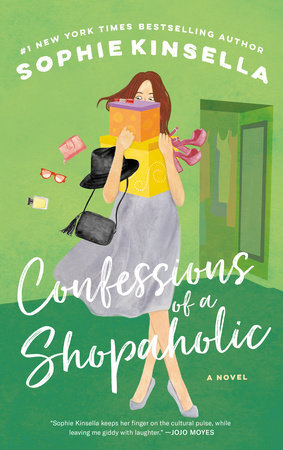 It’s exactly how I feel when I read the Shopaholic series by Sophia Kinsella. Whenever I pick up one of those books, I cringe through about 200 pages, wondering how Becky’s going to redeem herself. Yet somehow, she does it EVERY TIME.
It’s exactly how I feel when I read the Shopaholic series by Sophia Kinsella. Whenever I pick up one of those books, I cringe through about 200 pages, wondering how Becky’s going to redeem herself. Yet somehow, she does it EVERY TIME.
If you aren’t familiar with the series, the setup is that Rebecca Bloomwood is a financial journalist who writes articles about how to wisely manage money. Unfortunately, Becky has a serious shopping addiction, which means she takes none of her own advice. On top of that, the addiction leads to a spiral of lies and relationship issues. She is one of the most cringe-worthy characters I’ve ever read, but even as I wonder how she’s going to fix things, somehow by the end I’m satisfied and cheering her on to the next adventure.
As a reader, I’m often right there with my daughter in the middle of a book. I’m ready to reach in, shake a character, and talk some sense into them. But as a writer, if it’s done well, I’m ready to congratulate the author. That requires two main things.
I have to believe the character’s reasons for making the decisions, no matter how frustrating they are. In Becky’s case, she’s dealing with an actual addiction, and as a result, she digs herself into a deeper and deeper hole each time. While her justifications don’t work for me, I do believe that they make sense to her.I must be satisfied with the character’s resolution. If the character hasn’t significantly changed or worked toward correcting their mistakes, leaving me frustrated, then I won’t feel like the author delivered on the promise of the character arc.How do you know if it works? Well, readers will tell you that. Obviously that book series my daughter’s venting about works, as she continually restarts at the beginning. Just like me with Becky Bloomwood, my daughter can’t believe how wrong that character gets it at the beginning, but she keeps coming back to the story to watch the character redeem herself. These authors succeeded in writing characters who feel real–and in real life, we mess up a lot before we get things right.
That’s the mark of a masterful character and a successful character arc. I go along with Becky Bloomwood’s adventures over and over again because I trust that in the end she’ll figure things out–not because I expect her to make all of the right decisions along the way. Characters who make mistakes but correct them in the end are the ones who stick with readers for the long haul.
Do you have any characters to share who fit this profile? Or, on the other end, frustrated you but didn’t quite reach the redemption point?
The post The Character Cringe Factor (Or, Why Won’t They Just…) appeared first on Michelle I Mason.
April 9, 2024
Why Characters’ Traumatic Experiences Sometimes Feel So Real
Imagine planning your vacation for months, counting down the days. You set your alarm bright and early, take an Uber to the airport, check your bags, and settle in to wait at the gate. The flight’s a bit delayed, but then you board. The pilot comes on and says, “Folks, there was a lot of weather at the Orlando airport yesterday and they’re having some traffic issues. We’re trying to get a landing time, so we’re sitting tight for the moment.”
So you wait, sitting in a middle seat between a six-year-old child at the window and his dad in the aisle. The dad comments to you that the kid was nervous about someone sitting between them, and you wonder why he didn’t just sit next to him. Twenty minutes later the flight attendant comes on and says the flight is delayed more than an hour and you all have to exit the plane. You can leave your things if you want. No thanks.
You exit the plane and find a seat in the terminal. Fifteen minutes later you receive a notification that your flight has been rescheduled to the following day–arriving at 9:36 P.M. That’s not okay. You immediately make a beeline for the desk, but so does everyone else freaking out about the flight. How are you going to get to Orlando without missing another whole day of your trip? It would take 14 hours to drive there (arriving in the middle of the night), but it might be your only option.
Okay, I’m going to stop the story here.*

*Short conclusion: We found another flight, but our luggage did not come with us. Pictured here on the monorail the next day, wearing clothes purchased at Disney Springs. Our luggage came in the middle of night two.
But if you guessed this story actually happened to me, you’d be correct. It’s still pretty fresh in my mind, since it was only a month ago, when my daughter and I traveled to Disney World for spring break, but I know that as time passes, the details will fade. From the aspect of it being a really stressful time that impacted the beginning of our vacation, I want to forget it. But on the other hand, I learned all kinds of new details about how airlines handle things when your bags get separated from you, what you have to do to stock up on essentials on vacation when you don’t have access to a car, etc. So… I wrote down every single detail of how it played out. Why? Because you never know when I might decide to make a character go through that exact same scenario.
Like Maggie in My Second Impression of You. When I first conceived the idea of reliving a best day, there was no broken foot in that scenario. But then it happened to me. It was truly horrible and painful, but as soon as it happened, I started documenting. I took photos of how my foot looked at different stages, asked my doctor questions about how a teenager might heal differently, and took extensive notes about how I reacted to the surgery and medications.
No matter how sure you are that you’ll remember an event or experience, the details will never be so clear as when they’re first happening. Five years out from breaking my foot, I (thankfully!) no longer remember how many weeks I wore the surgical shoe versus the walking boot or the color/shape of the bruises. But if I needed to describe those things again, I could pull out my notes. It just turned out I wrote that story pretty soon after the experience happened  .
.
Writing down your emotions, the dialogue surrounding it, descriptions, and even taking photos/videos as applicable will help you recall everything more clearly if you decide to include a similar incident in the future. Of course, you’ll never need all the details (I deleted so many broken foot details in MSIOY  ), but the important thing is to have the information.
), but the important thing is to have the information.
And in case you think I’m only talking about traumatic experiences, I’m not. Cool and exciting experiences are also opportunities. Say you go skydiving and want to capture your emotional reaction or visit the Grand Canyon and feel you have to document it. If you don’t write it down soon, the details will begin to fade.
This isn’t an exhaustive list, but here are a few other things I keep notes about, from the big to the small:
Everywhere I travel, including descriptions of excursions, unique locals, people I meet, how I get around, etc. (pictures are great but don’t fully capture your impressions or interesting encounters)That time I forgot my ID and credit card and learned how the airport verifies your identity without themSitting in a McDonald’s and hearing the weirdest playlist everStrange interactions with people (like once being nicely but condescendingly heckled at an event)Childbirth (I mean, probably not going to write a book that includes it, but I’ve got the details!)Kid stuff – like stages at which my kids mastered different tasks or became interested in certain activitiesPractical jokes I’ve observedMedical stuff in general (for me and close friends/family)All about quarantineThere are more, but you get the idea!
In other news, my April newsletter is out today! In addition to this feature, it also includes a writing update and what I’m currently reading and watching. Subscribe here!
The post Why Characters’ Traumatic Experiences Sometimes Feel So Real appeared first on Michelle I Mason.
March 8, 2024
I See What You Did There (With That Twist)
Happy Spring!
At least it feels like spring to me, since spring break starts in about six or so hours. It’s a bit dreary here in Missouri at the moment, but if we wait a few days, that will change. Fortunately, I don’t have to wait for it, as I’m heading to Disney World! (Cue my usual disclaimer that my house will not be empty during this time.)

This line pretty much sums up my feeling about the movies I choose.
Anyway, a few weeks ago, I went to see the movie Argylle, and I haven’t been able to get it out of my mind. I loved it, over-the-top scenes and all, although I know it’s not everyone’s cup of tea. In fact, it’s not a lot of people’s, according to the reviews, but I would like to argue that it’s a really interesting study in writing twists. Because as I left that movie, I kept thinking about how every twist–and there were a lot–had been carefully planted. If you want to talk about overall believability or cheesiness (to which my son took exception), that’s a whole different thing. But when it comes to the twists in the movie, they all made sense. They were earned.
And that’s the sign of good writing, whether in a movie or book–that when a twist shows up in the story, you can point back to something earlier and say, “I see what you did there.” If it’s skillfully done, you won’t understand what it means at the time, but when the twist happens, you also won’t feel tricked or betrayed.
I don’t want to give away how it’s done in Argylle in case you haven’t seen it yet, but if you have, feel free to email me about it. Maybe you don’t agree, or maybe you were too ticked off about how weird it got or how long it went on to appreciate that part of it. So instead, here are a few examples of ways I’ve seen effective twists pulled off, along with one way that made me feel tricked.
The character who’s wrong – One really effective way to pull off a twist is for the main character to either make an incorrect assumption and/or just hold an incorrect belief from the beginning of the book. Because if the POV character believes it, the reader will believe it too and will not feel tricked; instead it will be more of an ah ha moment when the truth is revealed.
The unreliable narrator – An unreliable narrator has a compromised viewpoint, but for it to successfully work, there has to be a reason they’re unreliable. Or perhaps a certain technique that’s used to convey their story.
Transcripts, letters, etc. – Written/spoken communication works well for an unreliable narrator because the reader feels like they’re inside the character’s head, but their words are actually filtered. Everything they’re saying/writing could be a lie.Memory loss – Someone who’s missing chunks of time is bound to be unreliable because they can’t possibly know for sure what happened.Physically/mentally impaired – A character whose ability is impaired, either mentally or physically, may not have a clear view/understanding of events. This could include the inability to access all parts of an experience, whether they’re physically unable to get somewhere or unable to process information.Substance abuse – Someone who is under the influence of alcohol or drugs will be understandably unreliable.The liar – Perhaps the character is just a straight-up liar or has some other reason to conceal the truth from the reader (like they’re a criminal). Maybe the character admits from the beginning they’re a liar; if so, the reader might have it in the back of their mind but not know which thoughts to believe. It’s still a fine line to tread.Naive narrator – Younger characters often see things through a different lens and don’t completely understand what’s happening, particularly if they’re narrating an adult situation beyond their comprehension. But this could also be true of any character trying to narrate a situation they believe they understand but actually do not.The character who holds back information – This could technically go under the unreliable narrator category, but it doesn’t necessarily have to. I think if it’s done well and the character has a legitimate reason not to think about the information that’s being withheld, it’s a separate category. But if it’s done poorly, they become the worst kind of unreliable narrator–the kind where you want to throw the book across the room because the author just sat down beside you and said, “Hey, look what I did there!” Because you can’t help but be annoyed that the character never thought about that information throughout the whole book. That’s what it comes down to. Does the reader believe the character’s reasons for suppressing thoughts about it? If so, the author pulled it off. If not, they failed.
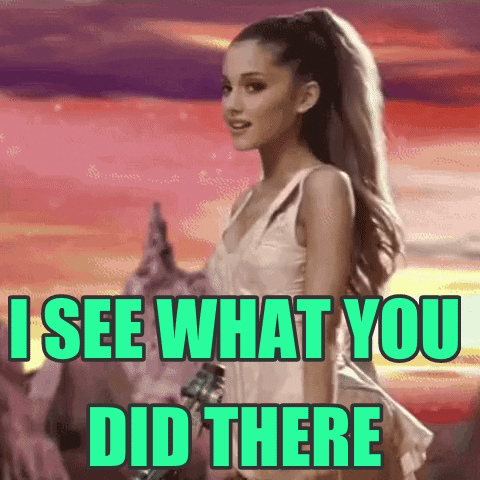 The out-of-nowhere twist – Sometimes twists don’t have anything to do with what the POV character is thinking or saying. Even so, I’d argue that a well-written twist can’t be completely out of nowhere. It should be well-grounded in the plot so that even if it’s shocking and takes the reader by surprise, they believe it fits within the world the writer has built.
The out-of-nowhere twist – Sometimes twists don’t have anything to do with what the POV character is thinking or saying. Even so, I’d argue that a well-written twist can’t be completely out of nowhere. It should be well-grounded in the plot so that even if it’s shocking and takes the reader by surprise, they believe it fits within the world the writer has built.
I started all of this talking about a movie, but of course all of this applies to books too. I definitely have certain books in mind when I mention each of these scenarios above, but if I told you what they were, it would have you reading while anticipating a twist. But you know what? Even some of the books where I’ve known there was a twist coming, I still didn’t figure out what it was until I got to it. Those are the most masterfully done. So if you have recommendations for books with truly amazing twists, please send them my way!
In other news, my March newsletter is out today! In addition to this feature, it also includes a recipe, an answer to a reader question, and what I’m currently reading and watching. Subscribe here!
The post I See What You Did There (With That Twist) appeared first on Michelle I Mason.
February 13, 2024
Choosing the Right Words for Your Novel
Happy February!
Last week, I participated in World Read Aloud Day for the third consecutive year. For the unfamiliar, World Read Aloud Day is an annual celebration of the power of reading aloud sponsored by LitWorld and Scholastic. Authors offer free virtual school visits during this one day of the year. Typically the visits include an intro, a read aloud (of course!), a Q&A, and generally the author shares a few book recommendations. This year, I virtually visited middle schools in California and New Hampshire and high schools in Alabama and Texas. The photos below are from the beginning and end of my day. I had an awesome time, but it was exhausting!


Every year, I’m so impressed by the questions students ask. There are some perennial questions like:
How long does it take to write a book?Do you ever get writer’s block?Have you written other books besides the ones that are published?But every time I talk with students, they surprise me with new and interesting questions. My favorite was: What is your skin care routine? It might have been a joke, but I took it as a compliment  . One school’s book club was currently reading My Second Impression of You, so they had used the MSIOY book club kit to make Maggie’s favorite Mocha cookie crumble Frappuccino and also asked some very specific questions about the book.
. One school’s book club was currently reading My Second Impression of You, so they had used the MSIOY book club kit to make Maggie’s favorite Mocha cookie crumble Frappuccino and also asked some very specific questions about the book.
But on to today’s topic, which was one of my favorite writing questions of the day.
How do you choose the right words for your novel?At first glance, you might assume this is a grammar question. It certainly can be, but on a bigger picture level, it’s really about character and voice. The words you choose are a reflection of your character’s point of view, particularly if you’re writing in first person or close third person.
So who is your character? Their age, ethnicity, where they live, family situation, beliefs, level of education, and a plethora of other factors will impact how they think and speak. Even for something as simple as noticing a car drive by, you would get vastly different internal thoughts/dialogue.
Of course, word choice goes beyond descriptions. It encompasses everything your character says and thinks. Are they observant, or do they go through life completely missing what’s happening around them? Do they speak what they’re thinking or hold nearly everything in? Do they have intricate knowledge about a particular topic and so are likely to go into a lot of detail whenever it comes up? Or even see the world through the lens of that passion?
Or… are we in a different world entirely and that’s going to inform your word choices? Fantasy and sci-fi worlds are sure to have unique word choices and terminology. As does historical fiction.
But wait, there’s more! Is your character prone to metaphors? Other literary devices? Short, choppy thoughts and dialogue or longer, more lyrical internal dialogue and discussion? Constantly crack jokes or not understand them at all?
All of these factors–and so many more!–affect the words you choose.
Let’s take the two main characters from my published books:
Now let’s take a prompt and modify it for each character with specific word choices.
Generic promptI’m so bored. I want to go somewhere fun. Where is everyone? I have to get out of this house.
JennyMaggieTwo thirty-three. Seriously? I swear it was two thirty-three the last time I glanced at the clock. Usually Julia Quinn’s books completely engross me. This calls for a change of scenery–and a list.
Things I can do to today (since everyone seems to be busy)
1. Walk to the park
2. Or the library for a new book
3. Go watch baseball practice
4. Work on the next issue of the Parkwood Press
Actually, I had an idea for an article about…
I can’t sit here for another minute, or I will die. Of boredom. But Rayna and Clara haven’t answered my texts for two whole hours.
Okay, fine. They’re both taking the SAT this morning, which I elected to skip, since it’s optional for my college choices. Whatever. I’m so sick of this house I’m tempted to make an appearance at Adam’s drills. Maybe I could stand on the sideline and break into a choreographed version of “My Shot” but switch up the lyrics for soccer. Oh, he’d want to kill me. Yesss!
Okay, so that’s a bit exaggerated, but hopefully you see the point I’m trying to make about voice and word choice.
It becomes especially tricky when you’re writing multiple viewpoints within the same novel. In that case, I usually revise each viewpoint separately to ensure I use distinct word choices for the characters.
Will you choose the right words in the first draft? Probably not! At least for me, the first draft is about getting the basic story onto the page, and revision is where the real magic happens. I generally find some gems that slipped in there and I keep through every draft, but it’s when I start analyzing the story carefully that I become picky about word choice.
Overall, my best advice for choosing the right words is to get to know your characters well so that you understand how they think and speak.
Now go choose your words wisely!
My February newsletter is out today, and it includes a Valentine quote quiz with a giveaway for subscribers. To ensure you don’t miss out on future giveaways, subscribe here.
The post Choosing the Right Words for Your Novel appeared first on Michelle I Mason.
January 9, 2024
What I Read in 2023
Happy New Year!
I’m already a couple of books into my reading for 2024, but it’s tradition for me to recap my year here on the blog, so here’s a summary of what I read in 2023.
My reading was up in 2023! I finished 90 books (versus 80 in 2022). I didn’t have a particular reading goal for 2023, but there ended up being a couple of trends.
First, since I was writing a mystery, I read a significant number of mysteries and thrillers, both young adult and adult.Second, I made a point of reading books that caught my attention, just for fun. So if I saw a book everyone was talking about, I picked it up to read, even if I had a list of books I’d intended to read for research purposes. (Quite honestly, SO MUCH of my reading is for research.) Which leads me to my third point…I read more non-fiction than I perhaps ever have in a single year. I generally only pick up non-fiction for research purposes, and as a result, it’s rare for me to read it cover to cover. All of these books grabbed my attention and kept me reading. Imagine my surprise when I wanted to read a book about plants from beginning to end!Fourth, I made a concerted effort to reread books on my shelves. I used to alternate these every third book in order to try and weed out any I’d outgrown. I didn’t quite get through that many, but I rediscovered some books I still love and also found a few to take to the used book store or a Little Free Library.Here are the stats breaking the books down by category, followed by the list with notes.
6 middle grade51 young adult26 adult7 non-fictionTotal: 90 books, including 15 rereads (mostly among the adult books but a couple YA)
The Betrayed by Kiera CassThe Ballad of Never After by Stephanie GarberAll of This Is True by Lygia Day PeñaflorReckless Girls by Rachel HawkinsMonday’s Not Coming by Tiffany D. JacksonYou Were Never Here by Kathleen PeacockA Study in Charlotte by Brittany CavallaroThe Cheerleaders by Kara ThomasThe Bodyguard by Katherine CenterOne Last Shot by Kip Wilson – Added to my permanent collection The Case of the Missing Marquess by Nancy SpringerSadie by Courtney SummersStalking Jack the Ripper by Kerri ManiscalcoThe House Swap by Yvette Clark –
Received an ARC, which is now part of my permanent collection
The Case of the Missing Marquess by Nancy SpringerSadie by Courtney SummersStalking Jack the Ripper by Kerri ManiscalcoThe House Swap by Yvette Clark –
Received an ARC, which is now part of my permanent collection  A Good Girl’s Guide to Murder by Holly JacksonTruly Devious by Maureen JohnsonOne Girl in All the World by Kendare BlakeMindhunter by John E. DouglasThe Vanishing Stair by Maureen JohnsonSeven Percent of Ro Devereaux by Ellen O’CloverGood Girl, Bad Blood by Holly JacksonThe Hand in the Wall by Maureen JohnsonFrench Kissing in New York by Anne-Sophie JouhanneauThe Cove by Catherine Coulter –
Reread
The Party Crasher by Sophie KinsellaDays of Gold by Jude Deveraux –
Reread
Perfect Shot by Debbie RigaudThe Case of the Left-Handed Lady by Nancy SpringerFinlay Donovan is Killing It by Elle CosimanoFlowerheart by Catherine Bakewell –
Added to my permanent collection
A Good Girl’s Guide to Murder by Holly JacksonTruly Devious by Maureen JohnsonOne Girl in All the World by Kendare BlakeMindhunter by John E. DouglasThe Vanishing Stair by Maureen JohnsonSeven Percent of Ro Devereaux by Ellen O’CloverGood Girl, Bad Blood by Holly JacksonThe Hand in the Wall by Maureen JohnsonFrench Kissing in New York by Anne-Sophie JouhanneauThe Cove by Catherine Coulter –
Reread
The Party Crasher by Sophie KinsellaDays of Gold by Jude Deveraux –
Reread
Perfect Shot by Debbie RigaudThe Case of the Left-Handed Lady by Nancy SpringerFinlay Donovan is Killing It by Elle CosimanoFlowerheart by Catherine Bakewell –
Added to my permanent collection  The Scent of Jasmine by Jude Deveraux –
Reread
The Case of the Bizarre Bouquets by Nancy SpringerNot An Easy Win by Chrystal D. GilesYou Wouldn’t Dare by Samantha Markum –
Added to my permanent collection
The Scent of Jasmine by Jude Deveraux –
Reread
The Case of the Bizarre Bouquets by Nancy SpringerNot An Easy Win by Chrystal D. GilesYou Wouldn’t Dare by Samantha Markum –
Added to my permanent collection  The Box in the Woods by Maureen JohnsonLavender Morning by Jude Deveraux –
Reread
A Whole Song and Dance by Sarvenaz Tash –
Added to my permanent collection
The Box in the Woods by Maureen JohnsonLavender Morning by Jude Deveraux –
Reread
A Whole Song and Dance by Sarvenaz Tash –
Added to my permanent collection  The Case of the Peculiar Pink Fan by Nancy SpringerGirl Forgotten by April Henry –
Added to my permanent collection
The Case of the Peculiar Pink Fan by Nancy SpringerGirl Forgotten by April Henry –
Added to my permanent collection  Throwback by Maureen GooBegin Again by Emma LordScarlet Nights by Jude Deveraux –
Reread
Nine Liars by Maureen JohnsonPlants That Can Kill: 101 Toxic Species to Make You Think Twice by Stacy Tornio –
This book was both fascinating and surprisingly funny, with entries like “You pretty much need to stay away from this one. There’s a reason people used it to poison others. The Bottom Line: No. Just no.” (About the strychnine tree.) After I talked about it so much, my husband bought it for me for Mother’s Day!
Well, That Was Awkward by Rachel VailThe Ballad of Songbirds and Snakes by Suzanne CollinsWhen the Vibe is Right by Sarah DassLuring a Lady by Nora Roberts –
Reread
Picture-Perfect Boyfriend by Becky DeanA Starlet’s Secret to a Sensational Afterlife by Kendall Kulper –
Added to my permanent collection
Throwback by Maureen GooBegin Again by Emma LordScarlet Nights by Jude Deveraux –
Reread
Nine Liars by Maureen JohnsonPlants That Can Kill: 101 Toxic Species to Make You Think Twice by Stacy Tornio –
This book was both fascinating and surprisingly funny, with entries like “You pretty much need to stay away from this one. There’s a reason people used it to poison others. The Bottom Line: No. Just no.” (About the strychnine tree.) After I talked about it so much, my husband bought it for me for Mother’s Day!
Well, That Was Awkward by Rachel VailThe Ballad of Songbirds and Snakes by Suzanne CollinsWhen the Vibe is Right by Sarah DassLuring a Lady by Nora Roberts –
Reread
Picture-Perfect Boyfriend by Becky DeanA Starlet’s Secret to a Sensational Afterlife by Kendall Kulper –
Added to my permanent collection  The Night in Question by Kathleen Glasgow & Liz Lawson –
Added to my permanent collection
The Night in Question by Kathleen Glasgow & Liz Lawson –
Added to my permanent collection  Save the Cat! Writes A Young Adult Novel by Jessica Brody –
Revolutionized my manuscript restructure! And yes, I read every single example, even the ones that didn’t apply to my book. Also added to my permanent collection.
Something Close to Magic by Emma Mills –
Added to my permanent collection
Save the Cat! Writes A Young Adult Novel by Jessica Brody –
Revolutionized my manuscript restructure! And yes, I read every single example, even the ones that didn’t apply to my book. Also added to my permanent collection.
Something Close to Magic by Emma Mills –
Added to my permanent collection  The Prince & The Apocalypse by Kara McDowell –
Added to my permanent collection
The Prince & The Apocalypse by Kara McDowell –
Added to my permanent collection  Book Lovers by Emily HenryWell, That Was Unexpected by Jesse Q. SutantoBorrow My Heart by Kasie WestTake Me Home Tonight by Morgan MatsonThe Blonde Identity by Ally Carter –
Added to my permanent collection
Book Lovers by Emily HenryWell, That Was Unexpected by Jesse Q. SutantoBorrow My Heart by Kasie WestTake Me Home Tonight by Morgan MatsonThe Blonde Identity by Ally Carter –
Added to my permanent collection  Always Isn’t Forever by J.C. CervantesManslaughter Park by Tirzah PriceEmma by Jane Austen –
Reread
The Brothers Hawthorne by Jennifer Lynn Barnes –
Added to my permanent collection
Always Isn’t Forever by J.C. CervantesManslaughter Park by Tirzah PriceEmma by Jane Austen –
Reread
The Brothers Hawthorne by Jennifer Lynn Barnes –
Added to my permanent collection  Saving Grace by Julie Garwood –
Reread
Reign by Katharine McGeeRed Velvet by Carla Luna –
Added to my permanent collection
Saving Grace by Julie Garwood –
Reread
Reign by Katharine McGeeRed Velvet by Carla Luna –
Added to my permanent collection  Mine Till Midnight by Lisa Kleypas –
Reread
Seduce Me At Sunrise by Lisa Kleypas –
Reread
Tempt Me At Twilight by Lisa Kleypas –
Reread
Married by Morning by Lisa Kelypas –
Reread
Love in the Afternoon by Lisa Kleypas –
Reread
Once Upon Another Time by James RileyOnce Upon Another Time Tall Tales by James RileyOnce Upon Another Time Happily Ever After by James RileyHighly Suspicious and Unfairly Cute by Talia HibbertWeep No More, My Lady by Mary Higgins Clark –
Reread
A British Girl’s Guide to Hurricanes and Heartbreak by Laura Taylor NameyGoing Vintage by Lindsey Leavitt –
Reread
Enchanted Hill by Emily Bain Murphy –
Added to my permanent collection
Mine Till Midnight by Lisa Kleypas –
Reread
Seduce Me At Sunrise by Lisa Kleypas –
Reread
Tempt Me At Twilight by Lisa Kleypas –
Reread
Married by Morning by Lisa Kelypas –
Reread
Love in the Afternoon by Lisa Kleypas –
Reread
Once Upon Another Time by James RileyOnce Upon Another Time Tall Tales by James RileyOnce Upon Another Time Happily Ever After by James RileyHighly Suspicious and Unfairly Cute by Talia HibbertWeep No More, My Lady by Mary Higgins Clark –
Reread
A British Girl’s Guide to Hurricanes and Heartbreak by Laura Taylor NameyGoing Vintage by Lindsey Leavitt –
Reread
Enchanted Hill by Emily Bain Murphy –
Added to my permanent collection  A Curse for True Love by Stephanie GarberA Smart Girl’s Guide: Babysitting, the Care and Keeping of Kids by Harriet BrownWitch of Wild Things by Raquel Vasquez GillilandDon’t Sit on the Baby: The Ultimate Guide to Sane, Skilled and Safe Babysitting by Halley BondyBreaking Cover: My Secrety Life in the CIA and What It Taught Me About What’s Worth Fighting For by Michele Rigby AssadThe Naturals by Jennifer Lynn BarnesLife Undercover: Coming of Age in the CIA by Amaryllis FoxThe Hunting Party by Lucy FoleyThe Woman in Cabin 10 by Ruth WareTell Me What Really Happened by Chelsea SedotiThe Unsinkable Greta James by Jennifer E. Smith
A Curse for True Love by Stephanie GarberA Smart Girl’s Guide: Babysitting, the Care and Keeping of Kids by Harriet BrownWitch of Wild Things by Raquel Vasquez GillilandDon’t Sit on the Baby: The Ultimate Guide to Sane, Skilled and Safe Babysitting by Halley BondyBreaking Cover: My Secrety Life in the CIA and What It Taught Me About What’s Worth Fighting For by Michele Rigby AssadThe Naturals by Jennifer Lynn BarnesLife Undercover: Coming of Age in the CIA by Amaryllis FoxThe Hunting Party by Lucy FoleyThe Woman in Cabin 10 by Ruth WareTell Me What Really Happened by Chelsea SedotiThe Unsinkable Greta James by Jennifer E. SmithIn previous years, I linked books on this list to reviews. However, I stopped writing reviews on the blog at the end of 2022. Instead, I often highlight books in my monthly newsletter. You can subscribe here, and my latest issue will be out later this morning.
The post What I Read in 2023 appeared first on Michelle I Mason.
December 12, 2023
Gift Ideas for Your Favorite Writer/Reader
Happy Holidays!
I don’t know about you, but every year I find it harder to put together a gift wish list for family members. It’s probably because I’m in that season of life where I’m mostly focused on my kids, so I’m not usually thinking about what I want for myself. And when there is something I’d like, I don’t need someone else to get it for me. However, just as I enjoy giving gifts to others, I understand they enjoy seeing me unwrap presents.
The last couple years, I’ve found myself Googling “gifts for writers” and “gifts for readers” when it’s time to make my list. I thought it would be helpful to share some of what I found. Plus I put out a call on Instagram for some additional tips. Now my list is even better!
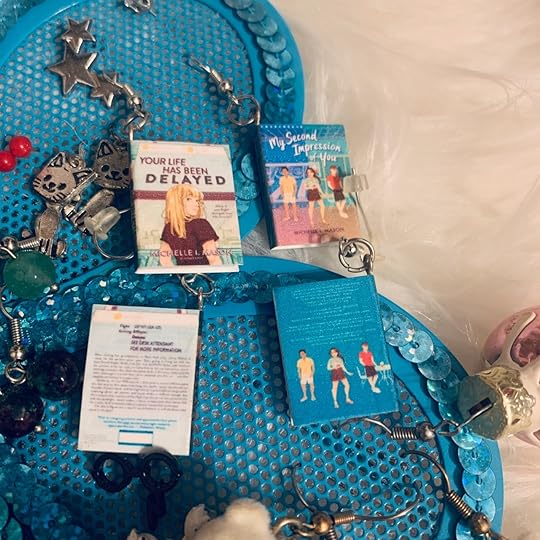 Book jewelry/swag. This is such a broad category and applies to both writers and readers. As an author, you will get me with anything that has my book covers on it. Pictured here are my custom book earrings. Every time I wear them, people comment–and ask about my books. I ordered these from EbbyEarrings on Etsy, but many shops offer them. MG/YA author Catherine Bakewell recommends InkandShrinkSwag for keychains, ornaments, and other items. But there’s so much more you can get–necklaces, bracelet charms, coasters, framed prints, cups, etc. Basically, if you could make something like it with your personal photos, you could also do it with a book cover.
Book jewelry/swag. This is such a broad category and applies to both writers and readers. As an author, you will get me with anything that has my book covers on it. Pictured here are my custom book earrings. Every time I wear them, people comment–and ask about my books. I ordered these from EbbyEarrings on Etsy, but many shops offer them. MG/YA author Catherine Bakewell recommends InkandShrinkSwag for keychains, ornaments, and other items. But there’s so much more you can get–necklaces, bracelet charms, coasters, framed prints, cups, etc. Basically, if you could make something like it with your personal photos, you could also do it with a book cover.
And readers love swag too! One reader replied to me that she loves fan art, t-shirts, overlays, and special covers. A simple search will lead you to all kinds of book swag, and if it’s a popular book, maybe it’s already available and ready to ship to you immediately.
Tot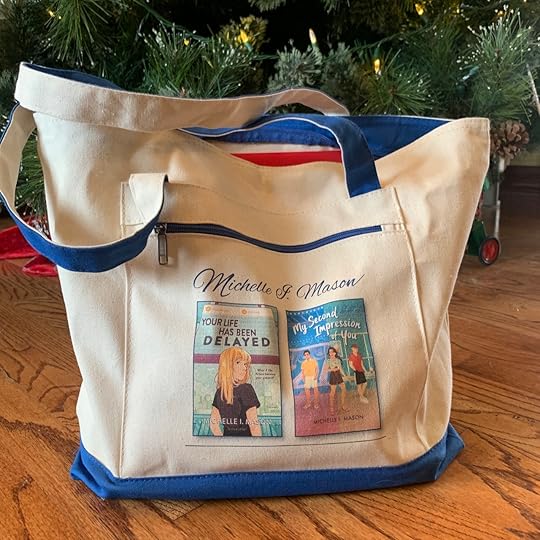 e bags. A sturdy canvas bag is great for carrying lots of books! Or, in my case, for carrying supplies to an event or signing. I asked for this one last year, and my aunt had it personalized with my name and book covers. I love it! I also have several totes from book festivals.
e bags. A sturdy canvas bag is great for carrying lots of books! Or, in my case, for carrying supplies to an event or signing. I asked for this one last year, and my aunt had it personalized with my name and book covers. I love it! I also have several totes from book festivals.
Paper products. On my desk right now, I have:
And I use them all. I’m constantly jotting down ideas and spreading them out until I have used the information, then I recycle and start all over.
Cool writing utensils. Another follower listed a quill pen as a favorite gift, and yes! Special pens, pencils, colored Sharpies and signing pens, etc., are fantastic gifts. We will use them!
Fingerless gloves. Okay, maybe this is just me: I am cold ALL THE TIME, but I also need my fingers to type or turn pages. Last year I received a four-pack of fingerless gloves, and I have them strategically stashed at my desk and reading areas to ensure my hands stay warm while working and reading.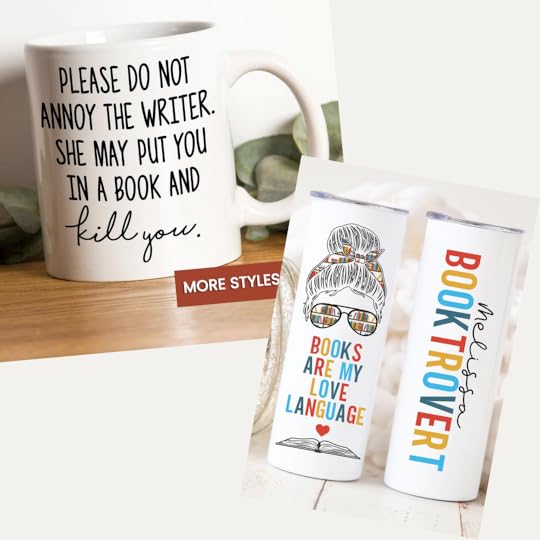 Mugs/cups. You can’t have too many mugs or cups, in my opinion. The cups I actually use to drink out of, and the mugs often end up on my desk as holders of things–especially if they have a cool saying. My favorite is one that says “I am silently correcting your grammar.” (My husband points out that maybe it’s sometimes not so silent
Mugs/cups. You can’t have too many mugs or cups, in my opinion. The cups I actually use to drink out of, and the mugs often end up on my desk as holders of things–especially if they have a cool saying. My favorite is one that says “I am silently correcting your grammar.” (My husband points out that maybe it’s sometimes not so silent  .)
.)
Gift cards. I mentioned gift cards like they’re a fallback, but they’re totally awesome. Here are a few great suggestions beyond the easy grabs at your local grocery/convenience store:
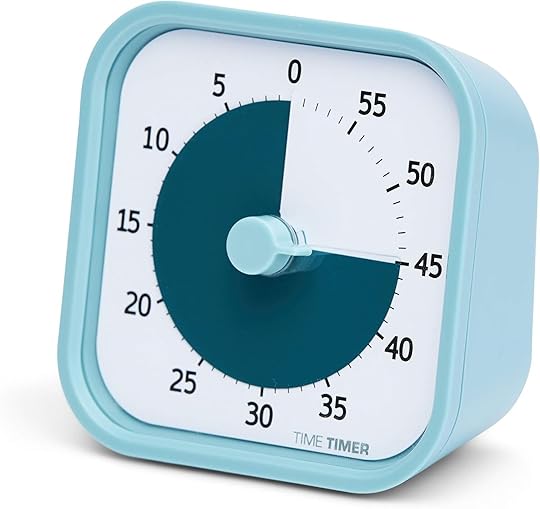 A timer. Catherine Bakewell offered another tip for writers–a physical timer for writing sprints. As someone who also does sprints while drafting, I love this idea. I’ve always used an online timer, but this way you can see how many minutes remain.
A timer. Catherine Bakewell offered another tip for writers–a physical timer for writing sprints. As someone who also does sprints while drafting, I love this idea. I’ve always used an online timer, but this way you can see how many minutes remain.
Bookmarks. You can never have too many bookmarks! Indie bookstores are another great resource for finding fun bookmarks, but also check out your neighborhood Barnes & Noble or gift shops. As a reader, I know I’m constantly misplacing my bookmarks, plus they eventually wear out, so it’s nice to have a running supply!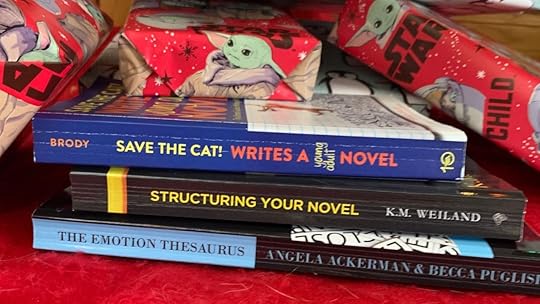 Books! Did I forget to mention books? Definitely buy any requested books, but if you find one you think someone will love, it doesn’t hurt to throw it into the mix! (But if you buy a book someone didn’t request, maybe don’t keep asking them if they’ve read it? Not every book is for every person.) And for the writers in your life, craft books are a great option too. Here are a few I highly recommend:
Books! Did I forget to mention books? Definitely buy any requested books, but if you find one you think someone will love, it doesn’t hurt to throw it into the mix! (But if you buy a book someone didn’t request, maybe don’t keep asking them if they’ve read it? Not every book is for every person.) And for the writers in your life, craft books are a great option too. Here are a few I highly recommend:
Baby name books, dictionaries, and actual thesauruses are also great resources. And if you want to make those books even more special…
Signed books. Until I started writing seriously toward becoming published myself, I had no idea I could get signed books from my favorite authors. Once I discovered this magical option, I started checking author websites to see where I could order them. It’s usually at their local indie. Sometimes they’ll even go personalize them for you! Speaking of which…
Check out my local independent bookstores, The Novel Neighbor and Main Street Books, for signed copies of My Second Impression of You or Your Life Has Been Delayed. Both stores have signed copies available, and I’m also happy to pop in to personalize. When ordering, make a note that you would like a signed copy and request any personalization.
The Novel Neighbor: YLHBD MSIOY
Main Street Books: YLHBD MSIOY
Happy shopping!
In other news, my December newsletter is out today. Check it out for a writing update, info on how to sign up for World Read Aloud Day, and what I’m currently reading/watching.
The post Gift Ideas for Your Favorite Writer/Reader appeared first on Michelle I Mason.
Michelle I. Mason
- Michelle I. Mason's profile
- 61 followers



